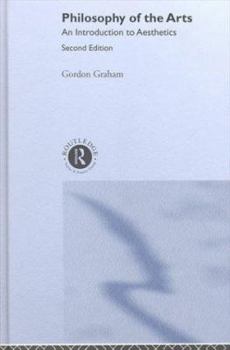Philosophy of the Arts: An Introduction to Aesthetics
Select Format
Select Condition 
Book Overview
Philosophy of the Arts presents a comprehensive and accessible introduction to those coming to aesthetics and the philosophy of art for the first time. The third edition is greatly enhanced by new... This description may be from another edition of this product.
Format:Paperback
Language:English
ISBN:0415235642
ISBN13:9780415235648
Release Date:September 2000
Publisher:Routledge
Length:240 Pages
Weight:0.95 lbs.
Dimensions:0.5" x 6.1" x 9.1"
Customer Reviews
1 rating
Understand the Philosophy of Art
Published by Thriftbooks.com User , 16 years ago
I read this book for a graduate seminar on the philosophy of art. Gordon Graham's "Philosophy of the Arts" is an excellent text to get a general idea of the vast field of philosophy of art. Aesthetics = philosophy of Art, thinking about art. Originally, aesthetics just meant "sense experience," and had nothing to do with art. A certain theory of art came to co-opt this word. So, much of modern philosophy of art turned more to the subject and away from the object because modern science did such to convince us that the objective world could be understood as a precise matter of mathematical physics. This idea became so impressive that people were making claims about art or ethics similar to science, that we can't make any objective claims about the world, we are simply making claims about human beliefs. So, the turn to the subject becomes common because of the success of modern science it co-opted the discussion of objective nature. We say things about art, but not all are true. The Ancient Greeks had absolute beliefs about art like "beauty." He finds that how we engage art today is different then how the ancient Greeks did, art was embedded in a cultural context for them. Art was not in museums or in dance halls. Art is in a special zone of experience today in museums, etc. Tragedy for Greeks was part of their politics and religion, sculpture and painting the same way. Music until recently, (after the enlightenment) was for religion or some kind of official function. Philosophy tries to come up with theories about art; it may be a fool's errand. A set of principles that define and illuminates or explains the full measure of art is probably not attainable. However, just because a theory is wrong doesn't mean it has no value, we can draw import from all of them. He asks, can art even satisfy necessary or sufficient conditions? One will always find exceptions. A "Necessary condition" is a condition that must be present in order to account for the subject in question, i.e., all art must have X. "Sufficient conditions" are considered to being all that is needed to be in account for the subject in question. Another word a complete sufficient condition means you have captured all that you need to account for. An example of a necessary condition and necessary conditions need not be sufficient conditions, so for instance a necessary condition for "being a bachelor is being a male," but it is not a sufficient condition because you have to have an "unmarried male" in order for it to be a sufficient condition for being a "bachelor." So both "unmarried and male" are necessary conditions, they both must be present in order to account for "bachelorhood," but neither one alone is a sufficient condition because it is not enough. So, when we are trying to define art and one finds some necessary conditions like some kind of "human intervention" that is a necessary condition, but maybe it is a sufficient condition if we want to understand o





